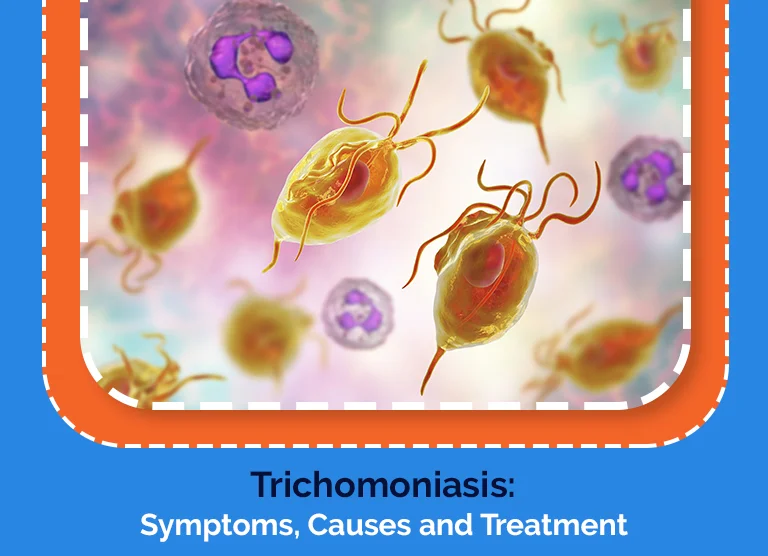
Monday to Friday 9:00 AM - 6:00 PM
Saturday to Sunday 10:00 AM - 2:00 PM
 Book Appointment
Book Appointment

Monday to Friday 9:00 AM - 6:00 PM
Saturday to Sunday 10:00 AM - 2:00 PM
 Book Appointment
Book Appointment

Trichomoniasis commonly shortenedas trich is a prevalent sexually transmitted infection (STI). Research shows that over 3 million persons have trichomoniasis, and most people remain unaware of it. However, with the right diagnosis at a walk in STI clinic, it is easy to treat.
Most times, trich infection shows no symptoms. Only about one-quarter of those infected with trich show symptoms. However, in the few cases, symptoms occur after 5 – 28 days of contracting the infection. Sometimes, it takes longer for symptoms to show.
For persons with a vagina, the following symptoms occur.
Common symptoms for people with penis include the following.
Trich results from contracting a one-celled protozoan called Trichomonas vaginalis. It is transmitted through genital sexual contact with an infected person or by sharing sex toys with an infected person.
In women, trich causes urethral or vaginal infection, and sometimes, infection in both parts of the body. In men, it only causes urethral infection. Once infected, you can transmit it to your sex partner when having unprotected sex.
It is impossible to contract trich through regular physical contacts like kissing, hugging or using the same toilet seat, sharing dishes with an infected person or any other sexual contact that does not involve the genitals.
Trich infections are more prevalent in women. Over two million women between the ages of 14 – 49 havetrich. More cases of trich infection are found in older people with vaginas. A recent study showed that more people over 50 years had trich.
Increased chances of contracting trichoccur with the following set of persons.
Symptoms oftrich infections are similar to other STI symptoms. Having the symptoms alone is not enough for diagnosis. If you think you have contracted trich, ensure you visit your doctor to get a laboratory test and physical exam.
Different tests, like the following help in the diagnosis of trich.
Antibiotics are sufficient for the treatment of trich. Your doctor may prescribe tinidazole or metronidazole.
Ensure you avoid alcohol for the first 24 hours after taking metronidazole and the first 72 hours after takingtinidazole. This can cause severe vomiting and nausea. Ensure your sex partner gets tested and takes medication if necessary.
Even if your sex partner does not show symptoms, it doesn’t mean they are not infected. You also need to avoid sexual contact for about a week after your treatment.
If you do not treat a trich infection, it will continue to cause harm to the body, but with treatment, trich can clear off within one week. If your partner did not get treatment for trich or your new sex partner has trich, you can contract the infection again.
Ensure you reduce your chances of contracting trich by ensuring your partner receives the necessary treatment and wait until you are sure the infection has cleared before resuming any sexual activity. Usually, it requires a week after treatment to have sex again.
Your symptoms should clear after a week, but if the symptoms persist, contact your doctor to get retested and treatment.
Ensure you visit your doctor three months after the treatment for a follow-up test. The rate of re-acquisitionfor women is about 17% within three months.Re-acquisition of trich can occur if your partner got the necessary treatment because trich is resistant to some medications.
You can get certain tests about two weeks after you treat trich to check if you still have the infection.
Having trich makes contracting other STIs easy. Genital inflammation resulting from trich makes it easy to have HIV, and it becomes easy to transmit HIV.
Conditions like bacteria vaginosis, chlamydia, and gonorrhoea often occur alongside trich. Untreated STIs may lead to pelvic inflammatory disease (PID), and PID complications include the following.
Trich usually causes certain complications in pregnant women. It increases the chances of premature delivery and giving birth to babies with low weight.In rare cases, babies contract the infection during delivery.
A pregnant woman can take tinidazole and metronidazole as there are no known complications of these medications to pregnancy.
If you are pregnant and feel you have trich, contact your doctor immediately to avoid complications that may affect you and the baby.
The only sure way to prevent trich is abstinence from all forms of sexual activity. However, you can reduce your chances of contracting trich and other STIs by using latex condoms or any barrier method during sex.
If you show symptoms of trich or think you have trichomoniasis, walk into the STI clinic or visit website to book an appointment with a sexual health doctor.
